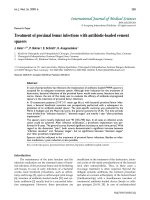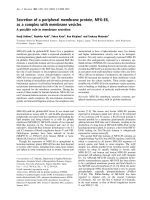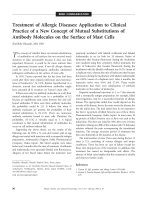Báo cáo y học: " Treatment of oroantral fistula with autologous bone graft and application of a non-reabsorbable membrane"
Bạn đang xem bản rút gọn của tài liệu. Xem và tải ngay bản đầy đủ của tài liệu tại đây (703.67 KB, 5 trang )
Int. J. Med. Sci. 2010, 7
267
I
I
n
n
t
t
e
e
r
r
n
n
a
a
t
t
i
i
o
o
n
n
a
a
l
l
J
J
o
o
u
u
r
r
n
n
a
a
l
l
o
o
f
f
M
M
e
e
d
d
i
i
c
c
a
a
l
l
S
S
c
c
i
i
e
e
n
n
c
c
e
e
s
s
2010; 7(5):267-271
© Ivyspring International Publisher. All rights reserved
Case Report
Treatment of oroantral fistula with autologous bone graft and application
of a non-reabsorbable membrane
Adele Scattarella
1
, Andrea Ballini
1
, Felice Roberto Grassi
1
, Andrea Carbonara
1
, Francesco Ciccolella
1
,
Angela Dituri
1
, Gianna Maria Nardi
2
, Stefania Cantore
1
, Francesco Pettini
1
1. Department of Dental Sciences and Surgery, University of Bari “Aldo Moro”, Italy
2. Department of Dental Sciences, University of Rome “La Sapienza”, Italy
Corresponding author: Dr. Andrea Ballini, Dept. of Dental Sciences and Surgery, Faculty of Medicine and Surgery, Uni-
versity of Bari “Aldo Moro”-Italy, P.zza G. Cesare n.11 -70124 Bari-Italy. E-mail: ; Tel:
(+39)0805594242; Fax: (+39)0805478043.
Received: 2010.06.23; Accepted: 2010.08.09; Published: 2010.08.11
Abstract
Aim: The aim of the current report is to illustrate an alternative technique for the treatment
of oroantral fistula (OAF), using an autologous bone graft integrated by xenologous parti-
culate bone graft.
Background: Acute and chronic oroantral communications (OAC, OAF) can occur as a
result of inadequate treatment. In fact surgical procedures into the maxillary posterior area
can lead to inadvertent communication with the maxillary sinus. Spontaneous healing can
occur in defects smaller than 3 mm while larger communications should be treated without
delay, in order to avoid sinusitis. The most used techniques for the treatment of OAF involve
buccal flap, palatal rotation – advancement flap, Bichat fat pad. All these surgical procedures
are connected with a significant risk of morbidity of the donor site, infections, avascular flap
necrosis, impossibility to repeat the surgical technique after clinical failure, and patient dis-
comfort.
Case presentation: We report a 65-years-old female patient who came to our attention for
the presence of an OAF and was treated using an autologous bone graft integrated by xe-
nologous particulate bone graft. An expanded polytetrafluoroethylene titanium-reinforced
membrane (Gore-Tex ®) was used in order to obtain an optimal reconstruction of soft
tissues and to assure the preservation of the bone graft from epithelial connection.
Conclusions: This surgical procedure showed a good stability of the bone grafts, with a
complete resolution of the OAF, optimal management of complications, including patient
discomfort, and good regeneration of soft tissues.
Clinical significance: The principal advantage of the use of autologous bone graft with an
expanded polytetrafluoroethylene titanium-reinforced membrane (Gore-Tex ®) to guide the
bone regeneration is that it assures a predictable healing and allows a possible following im-
plant-prosthetic rehabilitation.
Key words: oroantral fistula, bone regeneration, maxillary sinus.
BACKGROUND
Oroantral communications (OAC) are rare com-
plications in oral surgery, which recognize upper
molars extraction as the most common etiologic factor
(frequencies between 0.31% and 4.7% after the extrac-
tion of upper teeth
1
), followed by maxillary cysts,
tumors, trauma, osteoradionecrosis, flap necrosis and
Int. J. Med. Sci. 2010, 7
268
dehiscence following implant failure in atrophied
maxilla.
There is no agreement about the indication of
techniques for the treatment of this kind of surgical
complication. Spontaneous healing of 1 to 2 mm
openings can occur, while untreated larger defects are
connected with the pathogenesis of sinusitis (50% of
patients after 48 hours – 90% of patients after 2
weeks
2
).
Therefore, management of communications be-
tween oral cavity and sinus after tooth extraction is
recommended to promote closure within 24 hours
1-3
.
However, in patients with larger oroantral
communications and those with a history of sinus
disease, surgical closure is often indicated
1,2
.
Oroantral fistula (OAF) is an epithelialized
communication between the oral cavity and the max-
illary sinus. The fistula is established for migration of
the oral epithelium in the communication, event that
happens when the perforation lasts from at least 48-72
hours. After some days, the fistula is organized more
and more, preventing therefore the spontaneous
closing of the perforation
3
.
Many techniques have been described in order
to prevent the consequences of a chronical presence of
OAC, such as buccal flap, palatal rota-
tion-advancement flap and buccal fat pad
1,3-7
.
The problems linked to these techniques are re-
lated to the morbidity of the donor site, discomfort for
the patient, and no possibility to repeat the same
technique after surgical failure.
The aim of the present case report is to analyze
the healing of OAF with the associated use of an au-
tologous bone graft, integrated by xenologous parti-
culate bone graft, and a non- reabsorbable membrane.
CASE REPORT
We report a 65-years-old female patient who was
referred to our attention for the presence of sporadic
intraoral drainage in posterior left maxilla.
The discomfort was of a few years duration and
had its origin following an endodontic treatment of
tooth 2.6 provided four years before by her dentist.
The radiograph shows many characteristics of
OAC/OAF; the apexes of tooth 26 were in extremely
close approximation to the maxillary sinus, and an
area of periapical rarefaction was evident (Fig. 1).
After the failure of the endodontic treatment the
same tooth was subsequently extracted about five
months later by the same practitioner for the persis-
tence of symptomatology.
No pain occurred after the extraction, despite the
drainage.
The patient was able to give consent after re-
ceiving oral and written information.
From the anamnesis, no systemic pathology
came out.
Clinical examination of the area failed to disclose
any significant pathologic.
Periodontally, there were no pockets, none of the
remaining teeth were percussion positive, and the
palpation was negative for loss of periodontal attach
and abnormal movements.
The radiographic (Fig.2) examination did not
underline any discontinuity of the sinus floor, but
showed radiographic loss of lamina dura at the infe-
rior border of the maxillary sinus over the involved
tooth and the localized swelling and thickening of the
sinus mucosa; only close the root of 2.7 a periapical
lesion was present; radiopacity of different degrees
was evident in sinus space.
An explorative surgery was planned in order to
evaluate the presence of a possible communication.
One hour before the surgical procedure an anti-
biotic prophilaxis was performed with amoxicillin
and clavulanic acid 2 g.
The fixed partial prosthesis was removed and
the contiguous mucosa appeared healthy.
A buccal full thickness flap was harvested and
the presence of a small OAF was verified. (Fig.3).
After the evaluation of OAF dimensions (Fig. 4),
the surgical procedure was conducted by performing
an incision on the bone tissue surrounding the lesion
with bone drills and by harvesting a squared wedge
bone on the alveolar ridge, in order to avoid the per-
sistence of fibrotic tissue and to permit an adequate
bleeding.
An autologous bone graft was taken by a conti-
guous cortical site using a trephine with an inner
diameter matching the size of the bony defect. (Fig. 5).
The graft was press-fit into the defect and a
screw was inserted for internal fixation to increase
stability (Fig. 6).
The remaining vertical bone defect was filled
with a xenogenous bone graft (BIOSS®) (Fig 7), asso-
ciated to an expanded polytetrafluoroethylene tita-
nium-reinforced membrane (Gore-Tex ®).
A 3.0 silk detached suture was performed (Fig.8)
and topic medication with povidone-iodine solution
was applied. A systemic antibiotic prophylaxis with
amoxicilline and clavulanic acid 1g was prescribed
after 6 hours from surgery.
At 10 days from surgery the suture was removed
and the mucosa appeared healthy.
At 45 days from surgery, after non-reabsorbable
membrane removal (Fig. 9), the clinical control
showed an uneventful healing process with complete
Int. J. Med. Sci. 2010, 7
269
elimination of the bone defect. (Fig. 10). No pain, fever
or discomforts were described. The soft tissues ap-
peared healthy, with normal color, consistence and no
bleeding was present in the incision site and around
the periodontal pockets of mesial and distal teeth.
The 6 months control showed a normal healing
process. The radiographic evaluation with Compute-
rized Tomography demonstrated a complete regene-
ration of the osseous sinus floor (Fig.11).
Figure 1. Rx after endodontic therapy of tooth 26.
Figure 2. Rx after 26 extraction and following rehabilita-
tion with fixed partial prosthesis.
Figure 3. Flap elevation.
Figure 4. Demonstration of OAF existence by pin.
Figure 5. Autologous bone.
Figure 6. Graft stabilized with screw.
Figure 7. Defect filling with xenologous bone.
Int. J. Med. Sci. 2010, 7
270
Figure 8. Sutured flap.
Figure 9. Non-reabsorbable membrane removal.
Figure 10. Clinical evidence of bone healing.
Figure 11. CT at 6 months.
DISCUSSION
Periapical periodontitis may result in maxillary
sinusitis of dental origin with resultant inflammation
and thickening of the mucosal lining of the sinus in
areas adjacent to the involved teeth
4
.
This inflammation may be a consequence of
overinstrumentation and/or inadvertent injection or
extrusion of irrigants, intracanal medicaments, sealers
or solid obturation materials.
Furthermore, endodontic surgery performed on
maxillary teeth may result in sinus perforation that
develop into OAC
4
, than into OAF.
Numerous surgical techniques introduced to
close OAC and OAF include rotating or advancing
local tissues such as the buccal or palatal mucosa,
buccal fat pad, submucosal tissue, or tongue tissue
6
.
Most of them rely on mobilizing the tissue and
advancing the resultant flap into the defect
5
.
The closure of OAF is a major problem consi-
dering the phlogistic consequences of sinus mem-
brane infection, with the impossibility to perform im-
plant rehabilitation and pre-implant surgical proce-
dures. In addition, further implant surgery generally
requires more reconstructed bone at the implantation
site with a monocortical block. The final result is a
vascularized new bone formation which eventually
osseo-integrated with the surrounding bone.
Moreover, experimental studies confirm that
autogeneous bone graft assure more predictable re-
sults than xenogenous graft, in term of os-
teo-integration on the receiving site, in order to obtain
the closure of OAC, such as synthetic bone graft
substitutes constitute a valid alternative to flap based
techniques
7-11
.
The bone graft techniques for the treatment of
moderate to large OAC or OAF demonstrate to be
innovative, successful and predictable and permit to
avoid the clinical collateral effects, like morbidity of
the donor site, related to soft tissue flaps.
These techniques, similar to the one that we re-
ported, were innovative and successful for treating
moderate to large OAF.
CONCLUSIONS
OAF should be treated by establishing a physical
barrier to prevent infection of the maxillary sinus.
The closure of the communications with auto-
logous bone graft substitutes is a valid alternative to
flap based techniques.
Because of the continued need for implant reha-
bilitation and the necessity of preimplant surgical
procedures, such as sinus floor elevation, the routine
Int. J. Med. Sci. 2010, 7
271
soft tissue closure of OAF has become a major prob-
lem.
Therefore, a method that makes use of auto-
genous bone grafts harvested from the iliac crest for
the closure of the defects has been used
12
.
This method causes matting of the mucosae and
Schneiderian membrane and makes elevation of the
sinus membrane without disruption impossible
2
.
Clinical Significance
The principal advantage of the technique de-
scribed here is the use of autologous bone graft with
an expanded polytetrafluoroethylene titanium-
reinforced membrane (Gore-Tex ®) to guide the bone
regeneration assures a predictable healing and the
possibility of a following implant-prosthetic rehabili-
tation
12
.
Consent Statement
Written informed consent was obtained from the
patients for publication of this study and accompa-
nying images. A copy of the written consent is avail-
able for review by the Editor-in-Chief of this Journal.
Competing interests
The authors declare that they have no competing
interests.
References
1. Punwutikorn J, Waikakul A, Pairuchvej V. Clinically significant
oroantral communications—a study of incidence and site. Int J
Oral Maxillofac Surg 1994;23:19-21
2. Haas R, Watzak G, Baron M, Tepper G, Mailath G, Watzek G. A
preliminary study of monocortical bone grafts for oroantral
fistula closure. Oral Surg Oral Med Oral Pathol Oral Radiol
Endod. 2003 Sep;96(3):263-6.
3. Lee BK. One-stage operation of large oroantral fistula closure,
sinus lifting, and autogenous bone grafting for dental implant
installation. Oral Surg Oral Med Oral Pathol Oral Radiol Endod
2008;105:707-13
4. Hauman CH, Chandler NP, Tong DC. Endodontic implications
of the maxillary sinus: a review. Int Endod J. 2002 Feb; 35 (2):
127–141
5. Waldrop TC, Semba SE. Closure of oroantral communication
using guided tissue regeneration and an absorbable gelatin
membrane. J Periodontol. 1993 Nov;64(11):1061-6.
6. van den Bergh JP, ten Bruggenkate CM, Disch FJ, Tuinzing DB.
Anatomical aspects of sinus floor elevations. Clin Oral Implants
Res. 2000 Jun;11(3):256-65.
7. Gacic B, Todorovic L, Kokovic V, Danilovic V, Stojcev-Stajcic L,
Drazic R, Markovic A. The closure of oroantral communications
with resorbable PLGA-coated beta-TCP root analogs, hemos-
tatic gauze, or buccal flaps: a prospective study. Oral Surg Oral
Med Oral Pathol Oral Radiol Endod. 2009 Dec;108(6):844-50.
8. Ngeow WC. The use of Bichat's buccal fat pad to close oroantral
communications in irradiated maxilla. J Oral Maxillofac Surg.
2010 Jan;68(1):229-30.
9. Hernando J, Gallego L, Junquera L, Villarreal P. Oroantral
communications. A retrospective analysis. Med Oral Patol Oral
Cir Bucal. 2010 May 1; 15(3): 499-503
10. Visscher SH, van Minnen B, Bos RR. Closure of oroantral
communications using biodegradable polyurethane foam: a
feasibility study. J Oral Maxillofac Surg. 2010 Feb;68(2):281-6.
11. Ogunsalu CO, Rohrer M, Persad H, Archibald A, Watkins J,
Daisley H, Ezeokoli C, Adogwa A, Legall C, Khan O. Single
photon emission computerized tomography and histological
evaluation in the validation of a new technique for closure of
oro-antral communication: an experimental study in pigs. West
Indian Med J. 2008 Mar;57(2):166-72.
12. Cortes D, Martinez-Conde R, Uribarri A, Eguia del Valle A,
Lopez J, Aguirre JM. Simultaneous oral antral fistula closure
and sinus floor augmentation to facilitate dental implant
placement or orthodontics. J Oral Maxillofac Surg. 2010
May;68(5):1148-51.









